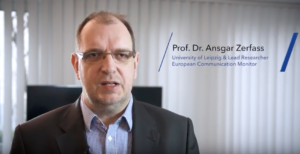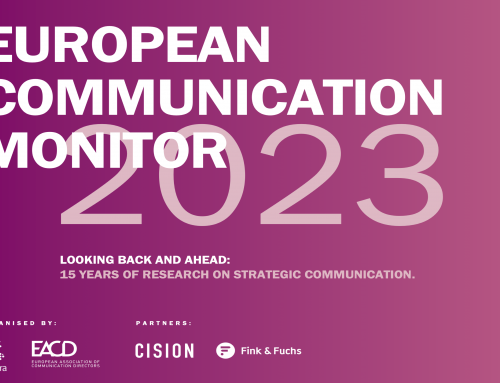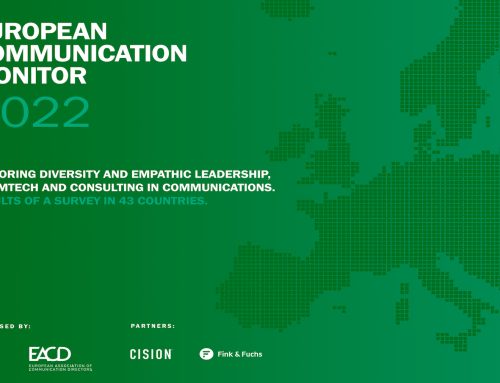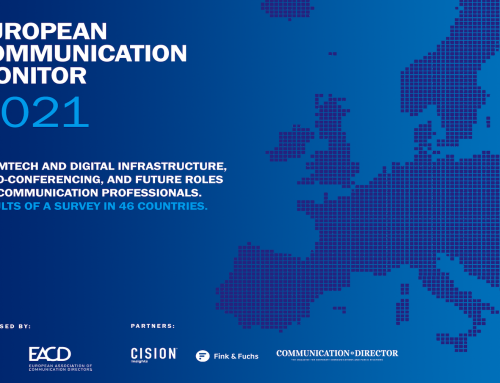 According to the European Communication Monitor 2015, launched at the European Communication Summit in Brussels on June 25, organisations are devoting more time than ever before to the evaluation of their communication campaigns and strategies. However leveraging the power of data for managing communications is still a key challenge for professionals across Europe. The survey reveals that only 43 per cent of all communication departments use insights gathered from measurement programmes to lead their in-house teams or agencies. A slightly higher number, 58 per cent, rely on data when reflecting on the direction of communication strategies, and 63 per cent use measurement outcomes to plan new activities. When explaining value to executives in their organisations, only 55 per cent of communicators aim to demonstrate the economic impact of their function.
According to the European Communication Monitor 2015, launched at the European Communication Summit in Brussels on June 25, organisations are devoting more time than ever before to the evaluation of their communication campaigns and strategies. However leveraging the power of data for managing communications is still a key challenge for professionals across Europe. The survey reveals that only 43 per cent of all communication departments use insights gathered from measurement programmes to lead their in-house teams or agencies. A slightly higher number, 58 per cent, rely on data when reflecting on the direction of communication strategies, and 63 per cent use measurement outcomes to plan new activities. When explaining value to executives in their organisations, only 55 per cent of communicators aim to demonstrate the economic impact of their function.
Although organisational listening is identified as a leading goal for strategic communication, the European Communication Monitor finds it is often neglected. While 78 per cent of organisations have established messaging strategies for reaching out to stakeholders, only 56 per cent use listening strategies to integrate feedback from stakeholders.
These are some of the key results found in this year’s European Communication Monitor (ECM), an annual survey based on interviews with 2,253 communicators in 41 countries.
Statements from the EUPRERA lead researcher and the EACD president
 Professor Ansgar Zerfass, lead researcher of the survey, explained:
Professor Ansgar Zerfass, lead researcher of the survey, explained:
“The study reveals that there is a vast discrepancy between the ambition of communication professionals to build immaterial assets, which they also claim as being valuable to top executives, and their practices of evaluating such impacts. Excellent communication departments are better at using measurement insights. And they collaborate more intensively with other functions in the organisation.”
 Dr. Herbert Heitmann, president of the European Association of Communication Directors (EACD) added:
Dr. Herbert Heitmann, president of the European Association of Communication Directors (EACD) added:
“The findings provide a direct line into the mindset of communicators across Europe. The dynamic development of the communication function during the digital age has opened up many new channels for reaching stakeholders. The majority of communicators surveyed in the European Communication Monitor believe the integration of these channels with those already in existence is crucial for a successful communications strategy. Through a continuous exchange with our members we hope to assist communicators in implementing innovative content strategies and data analytics.”
Future relevance of mass media
 Developments and changes of mass media significantly affect strategic communication practice. Communication professionals in Europe predict a tectonic shift from the predominance of mass media to owned media (which used to be called “corporate publishing”) for shaping public opinion. They intend to spend less on advertising (paid interactions with the mass media), while they see a strong rise in the use of unpaid interactions with the mass media (e.g. through media relations programs, 57.1 per cent believe this will gain in importance) and even more for strategic partnerships with the mass media (61.3 per cent gain in importance). Jointly produced quality content and/or creation of topical platforms will be especially relevant in Eastern and Southern Europe.
Developments and changes of mass media significantly affect strategic communication practice. Communication professionals in Europe predict a tectonic shift from the predominance of mass media to owned media (which used to be called “corporate publishing”) for shaping public opinion. They intend to spend less on advertising (paid interactions with the mass media), while they see a strong rise in the use of unpaid interactions with the mass media (e.g. through media relations programs, 57.1 per cent believe this will gain in importance) and even more for strategic partnerships with the mass media (61.3 per cent gain in importance). Jointly produced quality content and/or creation of topical platforms will be especially relevant in Eastern and Southern Europe.
Nevertheless it would be premature to predict the death of the traditional mass media: nearly three quarters of the respondents use the mass media to monitor news and public opinion (74.3 per cent), and more than two thirds of them evaluate media coverage of the organisation, its products and services. Besides these inbound uses of the mass media, communicators still extensively use the mass media for outbound reasons: more than seven out of ten respondents spread information about the organisation, its products and services through the mass media and more than half use them to influence gatekeepers, the media agenda and stakeholders.
This result is congruent with other studies on the current relationship between journalism and public relations. Perceptions of the future of media relations developments are largely dependent on the area of communication in which professionals are working. Strategic partnerships with the mass media are preferred by specialists in marketing, brand and consumer communication and those working in online media. Those specialists are also strongly in favour of concepts like content marketing, brand journalism and native advertising. Lines between advertising and publicity are blurring, and new rules of behaviour will be needed for professional communicators.
Strategic partnerships with the mass media are preferred by specialists in marketing, brand and consumer communication and those working in online media. Those specialists are also strongly in favour of concepts like content marketing, brand journalism and native advertising. Lines between advertising and publicity are blurring, and new rules of behaviour will be needed for professional communicators.
Integrating communications
In public relations thinking, there is often an axiom of the necessity to differentiate the function from marketing. On the other hand, there is a growing number of organisations as well as academics which advocate the need to integrate all communication functions, marketing communciations and public relations included.  85.6 per cent of respondents in this study believe that there is an overall need to integrate communication activities which affect all functions. The reason why: many believe that all communication functions nowadays use the full range of instruments online/offline, sometimes only under disparate names.
85.6 per cent of respondents in this study believe that there is an overall need to integrate communication activities which affect all functions. The reason why: many believe that all communication functions nowadays use the full range of instruments online/offline, sometimes only under disparate names.
But comparison to earlier monitor research from 2011 shows that there is hardly any progress in integrating communication by intra-organisational collaboration: ties between functions have not been strengthened during the last five years. Collaboration is stronger in publicly traded (joint stock) and private companies, and weaker in non-profit and governmental organisations. Nearly two thirds of respondents report that corporate communication is gaining in importance as it has a long tradition of handling content, while nearly half of respondents (64.0 per cent) also see marketing gaining in importance (45.2 per cent) as a consequence of the same processes.
Content strategies
Researchers are sometimes slow in addressing newly popular concepts of content strategy, brand journalism, content marketing and native advertising as if they are only passing hypes. Communication professionals in Europe, however, perceive these concepts as very important. There are significant differences between countries. For example, content marketing has high usage in the United Kingdom (72.6 per cent) as well as Finland (76.1 per cent), compared to Slovenia (47.1 per cent) and Croatia (46.4 per cent) who are slow movers in this respect. Major differences were also found for the usage of content strategy as well as brand journalism – the latter practice being very popular in Danish (57.1 per cent), Dutch (47.9 per cent), and British (45.9 per cent) organisations.
There are significant differences between countries. For example, content marketing has high usage in the United Kingdom (72.6 per cent) as well as Finland (76.1 per cent), compared to Slovenia (47.1 per cent) and Croatia (46.4 per cent) who are slow movers in this respect. Major differences were also found for the usage of content strategy as well as brand journalism – the latter practice being very popular in Danish (57.1 per cent), Dutch (47.9 per cent), and British (45.9 per cent) organisations.
Marketing, brand, consumer and online communicators are more in favour of these concepts than media relations and strategy and coordination people. There seems to be a defensive and conservative tendency at work here involving “traditional” public relations functions (e.g. media relations). Instead of using the integration of communication functions as an opportunity, also to organise an umbrella under which communications from marketing departments could migrate and feel welcome, many seem try to preserve their turf in what is a diminishing territory. Media are not what they used to be and the demarcation line between news and advertising is becoming fuzzy. There is no way that the lines between advertising/marketing and publicity/public relations could stay untouched. The question is not if different communications functions will integrate; the question is how and with what effect they will.
Strategic issues
“Linking business strategy and communication” continues to be the most important issue for communication management in Europe. It is mentioned by 42.9% of the communicators, leading the list of top issues for the third year in a row. This finding reiterates that the profession is continuing to strive for a strategic position at the decision-making table in order to become a part of the strategic management of an organisation.
Looking forward for the next three years to 2018, European communicators regard “Coping with the digital evolution and the social web” as the second most important challenge as it has returned to second place (37.2 per cent) in the list, after dipping to third last year. Meanwhile “Building and maintaining trust” is in the close third position (36.6 per cent). There are, however, very interesting differences between countries: “Linking business strategy and communication” is the hottest issue in Spain, Finland and Ukraine. “Coping with the digital evolution and the social web” is the top issue in Ireland, Belgium, Romania, Turkey and Croatia; “Building and maintaining trust” is the top issue in Slovenia and Sweden; while in France the top issue is “Matching the needs to address more audiences and channels with limited resources”.
Value contribution
 When explaining the relevance of strategic communication to top executives, eight out of ten communicators (79.8%) talk about positive effects of reputation, brands or organisational culture. Only every second (55.4%) tries to demonstrate economic effects. Many other ways exist to argue for the relevance of communication, and all of them are used by practitioners – so there is no consistent story told to those who pay the bill. However, the measurement and evaluation results of this study emphasise the contradiction that what respondents claim to do and what they monitor and measure do not match. The majority of activities reported as contributing to organisational goals are not monitored and measured, and for that reason it may be hard to defend, explain and legitimise them to top decision-makers.
When explaining the relevance of strategic communication to top executives, eight out of ten communicators (79.8%) talk about positive effects of reputation, brands or organisational culture. Only every second (55.4%) tries to demonstrate economic effects. Many other ways exist to argue for the relevance of communication, and all of them are used by practitioners – so there is no consistent story told to those who pay the bill. However, the measurement and evaluation results of this study emphasise the contradiction that what respondents claim to do and what they monitor and measure do not match. The majority of activities reported as contributing to organisational goals are not monitored and measured, and for that reason it may be hard to defend, explain and legitimise them to top decision-makers.
Communication strategies and organisational listening
While 78.3% of all organisations have established messaging strategies for reaching out to stakeholders, only 55.7% use a listening strategy to monitor the public sphere or integrate feedback from stakeholders. The most important structures and techniques for organisational listening are media monitoring  on a regular basis (used by 84.1 per cent), social media monitoring (68.3 per cent), ad hoc listening activities (58.2 per cent), issues monitoring and management (58.0 per cent) and regular dialogues with stakeholders (53.3 per cent). It is clear from the findings that joint stock companies lead the way in the practice of organisational listening.
on a regular basis (used by 84.1 per cent), social media monitoring (68.3 per cent), ad hoc listening activities (58.2 per cent), issues monitoring and management (58.0 per cent) and regular dialogues with stakeholders (53.3 per cent). It is clear from the findings that joint stock companies lead the way in the practice of organisational listening.
An in-depth analysis into the identification of listening-minded communication departments shows that 18.9 per cent of departments can be labelled as being ahead of the rest: they are better in contributing to overall objectives by identifying  opportunities, in explaining communication value though the benefits of listening, in implementing listening strategies and in spearheading listening within the organisation. The main differentiating aspect is that they are making listening tasks an explicit objective for the communication function (62.0 per cent versus 31.5 per cent of other departments) and listening tasks are also more often a part of the communicators’ job description (64.5 per cent against 33.4 per cent).
opportunities, in explaining communication value though the benefits of listening, in implementing listening strategies and in spearheading listening within the organisation. The main differentiating aspect is that they are making listening tasks an explicit objective for the communication function (62.0 per cent versus 31.5 per cent of other departments) and listening tasks are also more often a part of the communicators’ job description (64.5 per cent against 33.4 per cent).
Measurement and evaluation
Assessing results and processes of communication enables practitioners to demonstrate the value of their activities. The 2015 monitor shows that practices in this field have not changed much durnig the last five years, when the topic was researched before. Output measures like clippings and media responses (82.4 per cent), internet/intranet usage (68.9 per cent) and the satisfaction of (internal) clients (57.5 per cent) lead the way before measures looking at input (costs) and outcome (stakeholder knowledge and attitudes), with outflow measures at the bottom (impact on financial/strategic targets or intangible/tangible resources).  This shows that communicators are still focussed on media and channels, while they care less about the resources used to initiate communication processes, on the stakeholders addressed by communication activities, and most importantly on any results this has for the achievement of organisational goals. Worth reflecting is also the low percentage of communication departments using measuring data for leading communication teams or steering agencies and service providers (43.3 per cent). Slightly more are using these insights into processes to reflect goals and direction of communication strategies (58.0 per cent) or planning new activities (62.9 per cent). Nevertheless, the value of data for managing strategic communication seems to be overseen by many professionals today.
This shows that communicators are still focussed on media and channels, while they care less about the resources used to initiate communication processes, on the stakeholders addressed by communication activities, and most importantly on any results this has for the achievement of organisational goals. Worth reflecting is also the low percentage of communication departments using measuring data for leading communication teams or steering agencies and service providers (43.3 per cent). Slightly more are using these insights into processes to reflect goals and direction of communication strategies (58.0 per cent) or planning new activities (62.9 per cent). Nevertheless, the value of data for managing strategic communication seems to be overseen by many professionals today.
Relationship between agencies and clients
The use of agencies, consultancies and freelance practitioners is a common practice in communication management. The findings from this survey verify this practice across all types of organisations in Europe. Most of all the communication departments work on an ongoing basis with multiple agencies. In fact only one in five organisations (20.7 per cent) do not work with outside agencies at all, and 13.8 per cent of organisations work on an ongoing basis with a single “agency of record”. However communication departments and agencies have very different perceptions of why they work together. While both sides are close on the need to  integrate creativity and use additional “arms and legs”, there are wide misperceptions on the side of agencies that they are more often employed for expertise; strategic insight; objective, independent counsel; their ability to understand and explain communication trends and new instruments; and being able to support in explaining communication strategies to top executives.
integrate creativity and use additional “arms and legs”, there are wide misperceptions on the side of agencies that they are more often employed for expertise; strategic insight; objective, independent counsel; their ability to understand and explain communication trends and new instruments; and being able to support in explaining communication strategies to top executives.
In summary the agencies are more optimistic about their overall value and contribution to the client organisations when compared with the clients’ own responses. There are also wide differences in assessing reasons for agency-client conflicts. While clients see the main reason for conflicts originating in the lack of knowledge of the client’s business and processes (62.3 per cent), only one in five respondents on the agency side see this as a problem (21.0 per cent). On the other hand, nearly three quarters of agency respondents named unclear objectives and expectations as the main reason for conflicts (73.0 per cent), while only a third of respondents from the client side see this as a major reason (33.3 per cent). Obviously each side blames the other one for conflicts.
Characteristics of excellent communication functions
Benchmarking approaches based on self-assessments are established methods to identify excellent organisations as well as drivers of excellence within a field. Such approaches have been used for a long time in business and management. The ECM 2015 employs a new method to identify excellent communication functions, combining conceptual considerations with self-assessments of communication professionals and statistical analyses to identify characteristics which make a difference. The sample was divided between organisations with excellent communication functions and all other organisations. Excellence is based on the internal standing of the communication function within the organisation (influence) and external results of the communication function’s activities as well as the function’s basic qualifications (performance).
There are significant differences between excellent and normal communication functions. Excellent communication departments use mass media and their products more frequently, they help to reach overall goals more often than other communication functions/departments, they have professionals with higher levels of experience in evaluation practices, and they are more active in using insights from communication measurement in their organisations. They are also more likely to, and will with increased frequency, collaborate with other functions and departments within the organisation.
Interestingly, excellent communication departments also hire agencies and consultancies for different reasons than other communication functions. They hire support more often for creativity and innovation, expertise regarding specific geographies or markets, strategic insight, objective counsel and for explaining / understanding communication trends and new instruments. Other, non-excellent departments more often hire agencies because they are not allowed to hire additional staff internally, because agencies are cheaper than adding staff, so they are saving money. Excellent departments also take the lead in organisational listening within their organisations and they engage with more techniques for listening.
Last but not least, an important attribute of excellence as identified by this study is the ability to explain the value of communication to top executives by using arguments related to economic success and the benefit of listening to stakeholders. While excellent departments use all modes of explanation more intensively, they differentiate most in those two dimensions and in the recollection of threats caused by troubled relationships and crises. This indicates that communication management has to be conceptualised as a strategic discipline, incorporating both messaging and listening, with a clear commitment to demonstrate and evaluate the contribution to overall organisational goals.
Report, video and further material available
The PDF report with full results as well as a video featuring highlights from the study as well as more material like 10 Starting Points for Discussion or articles published in the Communication Director Magazine are available here.







